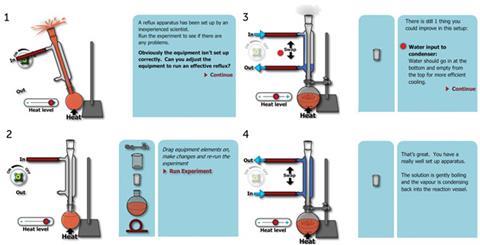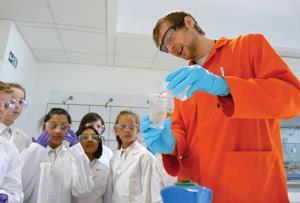What can be learned from the Bristol ChemLabS centre for excellence in teaching and learning 10 years on? Timothy Harrison, Nicholas Norman and Dudley Shallcross explain
Bristol ChemLabS, the centre for excellence in teaching and learning (CETL) in practical chemistry at the University of Bristol, is 10 years old. The centre was created by the school of chemistry with a £5m award from HEFCE (the higher education funding council for England), which was coupled with further investment from the university. This enabled the complete refurbishment of the teaching laboratories and the acquisition of new equipment. It also funded the development of teaching resources that transformed the practical experience for chemistry undergraduates, with associated benefits for postgraduate students, school pupils, their teachers and the general public.

The original CETL proposal had three main objectives: to bring the existing teaching laboratories up to the standard required to train a 21st century chemist; to create a web-based pre-, in- and post-lab resource to augment the laboratory experience; and to expand the school of chemistry’s outreach capabilities. HEFCE expected all CETLs to be sustainable beyond the five-year funding term of the award.
Refurbishment
The teaching laboratories in the school of chemistry prior to 2005 suffered from insufficient fumehoods and a dearth of modern analytical instrumentation. These issues were addressed during the refurbishment, resulting in new labs with ample fumehood provision and modern, industry-standard analytical instruments and laboratory apparatus. Academic and technical staff, in conjunction with architects and project managers, worked closely with contractors to ensure the laboratories delivered were entirely fit for purpose, on time and on budget.
The two floors of laboratories were configured into six practical teaching areas arranged around a central technical area with an open plan lobby and teaching space. Each area can accommodate a little over 100 students doing individual practical work at any one time. Equipment kits are provided for each experiment, and experimental stations remain static while students move around the stations throughout the course. This arrangement facilitates ease, speed and simplicity when resetting the laboratories, and experiment kits are checked on completion of the practical task as part of the assessment.
Much consideration was given to the use of the new laboratories when undergraduates are not present. This is achieved through extensive outreach activities and training courses for industrial placement students with GlaxoSmithKline and other higher education institution (HEI) training courses. The laboratories remain a national resource that welcome fellow academics and architects from other institutions to discuss their own designs, thereby assisting in other refurbishments and new laboratory builds.
The school of chemistry also took the opportunity to reassess the experiments undergraduate students carry out during their course. Rather than a traditional inorganic/organic/physical structure with practical work used to illustrate lecture material, experiments were revised and designed specifically to teach core practical chemistry skills appropriate to each year group.
The dynamic laboratory manual
Pre-laboratory software support for each experiment was a central theme of the CETL project. The resulting web-based dynamic laboratory manual (DLM) 1 contains practical scripts, risk assessments, videos showing techniques, fully interactive simulations of equipment and theoretical support by way of interactive online tutorials. The DLM also contains online quizzes on safety and practical tasks within an experiment, which link back to an online marks and attendance register and provide direct and immediate feedback to students.

Having established a comprehensive suite of DLMs for 1st, 2nd and 3rd year undergraduate students, the concept was extended to support key aspects of doctoral training in the school of chemistry. The same concept was also used to construct a commercial resource, A-Level Chemistry LabSkills, to support practical teaching at post-16 chemistry, along with a parallel product for use in HEI chemistry departments. Sponsorship from the Royal Society of Chemistry and Pfizer resulted in A-Level Chemistry LabSkills being made available to every secondary school in the UK and to graduate trainee teachers during a two-year period. Subsequently, the LabSkills packages were developed in association with Cengage Learning Inc. to support freshman chemistry laboratory teaching in the US. LabSkills products have now sold in over 30 countries across five continents.
One of the key benefits of DLMs is that students are able to make best use of their time in the laboratory by engaging in pre-lab activities, including online tutorial support, pre-lab assessment and safety training. Research shows that with the facility to rehearse experiments beforehand, new undergraduates are able to set up and use equipment without waiting for a demonstration. This enables demonstrators to engage students in higher order thinking skills and allows in-laboratory assessment rather than assessing practical skills from post-laboratory reports: a reduction in the number of lab scripts was welcomed by staff and students. To evaluate students’ ability to write reports, practical skills are first assessed in the laboratory and then the write-up is marked against criteria for report writing. To aid students in the latter, an online tutorial gives examples of good and bad reports.
The DLM concept has been extended within the University of Bristol to support undergraduate laboratory teaching across most years in biological sciences, biochemistry and related medical sciences, dentistry, physics, and electrical and electronic engineering. Moreover, dynamic laboratory techniques manuals (DLTMs) in physics and biological sciences designed to aid transition from post-16 study through to the crucial first few terms at university have been created through sponsorship by the Higher Education Academy and are available free of charge to UK departments.
Throughout the development of the DLMs, focus groups of undergraduate students were established to provide input at all stages of construction and post-introduction. Moreover, all university DLMs have been constructed to allow changes to the text, ensuring they are kept up to date and that continual improvements can be made.
Outreach programme
Establishing a school teacher fellow (STF) position was a natural progression for the successful outreach programme already in place. The STF is an experienced secondary school chemistry teacher charged with finding ways in which school of chemistry resources can be used to stimulate an active interest in chemistry in school students, teachers and members of the wider community.2 There are many advantages to using an existing teacher as the STF, the most important of which are confidence in communicating and the ability to choose appropriate activities. The STF also provides input into undergraduate teaching programmes, particularly for first year students.

In the first five years, the outreach team consisted of an academic lead, an STF, an outreach technician, an administrator and a primary science specialist/postdoc. In the last five years, the STF has overseen the running of the outreach programme. A considerable number of chemistry postgraduate students have been employed as demonstrators and speakers, and they all (now more than 500) have been trained as STEM ambassadors. Those engaged in the RSC’s Spectroscopy in a Suitcase project, working in primary schools and giving short talks and lectures, have additional training sessions. They are an outstanding resource for the promotion of chemistry and benefit enormously themselves.3
It has emerged that for young learners, accruing ‘science capital’ is a key factor in whether they maintain an interest in science, and recruitment-based outreach strategies are likely to miss out on these pupils.4 Bristol ChemLabS outreach promotes chemistry and has never made recruitment the focus. The outreach programme has engaged in face-to-face chemistry for 25,000–30,000 primary and secondary students and teachers each year for the last seven years with regional, national and international activities.
The programme was established with funds from the CETL project but became financially self-sustaining in terms of its direct costs after four years. Income streams are varied and include schools paying for activities, research grant impact funding, outreach grants and donations.
For teachers to be willing to fund an outreach activity, it must be of at least very good, if not outstanding, quality. What they expect of a chemistry outreach programme is consistency in provision, consistency in standard and an element of aspiration raising with the students. Moreover, for teachers to embed links with a university department, the activity must be available year-on-year. It should be noted that in the 2014 research assessment exercise (REF), one impact case study involving outreach within atmospheric chemistry research was rated as 4*.
Regular communication with schools is maintained by a monthly e-newsletter and an outreach website. A network of teachers, CHeMneT, has been established over the last 16 years, which now numbers over 1000 teachers. Apart from imparting a sense of community and partnership, the e-newsletter advertises activities up to a year ahead and provides information such as the availability of RSC outreach grants.
The concept of school teacher fellows was adopted by the RSC as part of the Chemistry for our Future programme5 (11 STFs), linked with AstraZeneca (two STFs) and via the HE STEM initiative (four STFs) where chemistry teachers were installed in English universities on secondments. Several of the STFs were adopted on a permanent basis. Unfortunately, no new STFs have been funded for the last few years despite their obvious success.
Conclusion
The success of the Bristol ChemLabS outreach project is first and foremost due to a department-wide commitment; staff, students, and technical and administrative staff have all embraced the project. Second, the longevity of the project is down to prudent financial planning that has allowed the project to carry on when many other programmes have come and gone. Third, the recruitment and establishment of an STF was pivotal in the success of the programme but so was the incredible support given by postgraduate students and postdoctoral researchers. As young role models, these groups have played a vital role and have benefited from being part of the project. Much of the CETL project is portable to other departments.
Timothy Harrison is the Bristol ChemLabS school teacher fellow and outreach director.Nicholas Norman is head of the school of chemistry and Dudley Shallcross is professor of atmospheric chemistry at the University of Bristol, UK
References
- D E Shallcross et al, A dynamic laboratory manual. Higher Education Academy, innovative pedagogies series, 2015
- D E Shallcross and T G Harrison, Chem. Educ. Res. Pract., 2007, 8, 101 (DOI: 10.1039/B6RP90023B)
- T G Harrison et al, New Dir., 2011, 7, 13
- J DeWitt et al, Int. J. Sci. Educ., 2013, 35, 1037 (DOI: 10.1080/09500693.2011.608197)
- J Tunney, New Dir., 2009, 5, 7









No comments yet